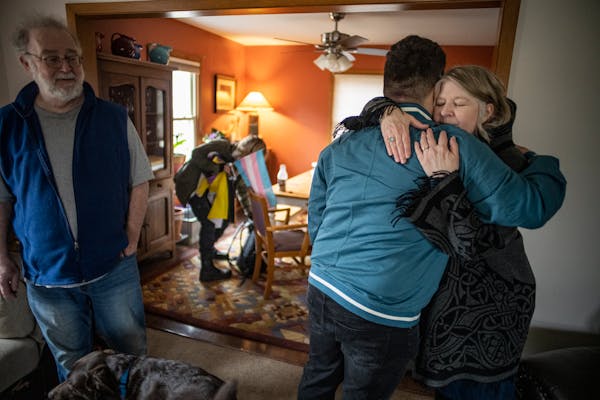Lindsey Port struggles some days to grip her pen or firmly shake hands, something she has to do a lot in her job as a Minnesota state senator.
She takes her longer meetings sitting down or over Zoom. Her sneakers are no longer a fashion statement but a necessity to deal with recurring numbness and tingling in her toes and feet. Sometimes, that feeling spreads to part of her leg, forcing her to walk with a cane.
COVID-19 has transformed the life of the 39-year-old DFL legislator and mother of two, who said the effects of the virus linger in her and many others who have long COVID. For Port, the mysterious diagnosis can feel like a "new form of isolation" as the rest of the world tries to move on from the pandemic, including some of her colleagues at the Capitol.
"In this place it feels like everyone thinks the pandemic is done," said Port in an interview in her St. Paul office. "It's a little painful and frustrating for me to hear that, because I'm literally sitting here in pain because of it, and I have unanswered questions and changes to my life. I know that I'm far from alone in that."
Long COVID remains a perplexing problem for the medical community, which is still trying to understand why some people develop long-term effects, who is most at risk, how to treat the condition and possibly prevent people who contract the virus from having lasting health implications.
"People are still getting COVID right now and people are starting to get symptoms of long COVID right now," said Port. "It's not over and it's important for us as leaders to remember that. We need to say that part out loud."
Port caught the virus early in March 2020, before Minnesota had confirmed its first COVID-19 death. Her husband had recently returned home from traveling and the state was just starting to close down classrooms and businesses to slow the spread of the virus.
Her fever spiked and she wound up in the emergency room. Doctors knew little about the virus at the time, so they sent her home with an inhaler and told her to come back if she couldn't breathe.
Back home, Port struggled to do simple things like walk around the block with her kids. The windows in her Burnsville home stayed shut all summer because campfire smoke triggered asthmatic attacks, something she'd never had before. Port started to feel like herself again by the end of the summer, but that's when the tingling started in her fingers and toes.
"That feeling when your hands falls asleep, it felt like that," she said. "It was annoying, but not anything that I was worried that much about."
She also started getting kidney stones, a red flag for her doctor. Decreased kidney function is a leading symptom of long COVID in women younger than 50. A biopsy showed her kidneys were healthy, but her brain wasn't telling her kidneys to do their job. She had to do a short stint of dialysis until her kidneys were functioning properly again.
Since then, the numbness has spread from her fingers and toes to her hands and feet. It can sometimes numb part of her leg for an hour or much longer, affecting her ability to balance properly. It's called neuropathy, which causes both numbness and pain.
"It felt temporary after the initial infection. Maybe this will take a little while to figure out, but we'll figure it out," said Port. "Now it feels like it's time for me to also accept that this is, at least for now, my new normal."
Neurological issues, brain fog, extreme fatigue as well as eye and throat issues are common signs of long-haul COVID, said Dr. Greg Vanichkachorn, medical director of Mayo Clinic's COVID Activity Rehabilitation Program.
Conservative estimates show between 10 and 20% of people who contract the virus come down with long-haul COVID, affecting millions of Americans. It's not rare, he said, even if it's not yet widely understood.
"Some people don't even think COVID-19 exists, so it's even more difficult to tell them that long-haul COVID exists," he said. "Patients start to question it themselves. It can make them feel depressed and anxious."
His program has seen 600 patients since June 2020 and they have a better idea now of what the condition looks like. Now, they're turning to finding treatments to help people get better faster.
"I tell patients if they have long-haul COVID they need to prepare for the long term. That being said, I don't want them to lose hope that we can't turn this around with new treatments," he said. "Keep engaged with the fight, keep engaged with your providers about this; don't bottle it up and hide."
Port's hope in talking about her struggles is that others might realize they are not alone. She's found solace in talking to a community of doctors and other long-haulers, which has made the experience less isolating.
She has hope when she sees steps being taken on the federal and state level to better prevent, detect and treat long COVID, but that progress can continue only if more people go in for treatment.
"We're not going to find solutions if we don't have a full grasp of the problem, so we need people to get in to their doctors," she said. "We need people to help us, together, find what this looks like long-term and what the solutions are to help people who are suffering. We can't do that if only a small group of us are talking, or if we're only talking in private."

Souhan: This is KAT's chance to prove Flip Saunders was right

